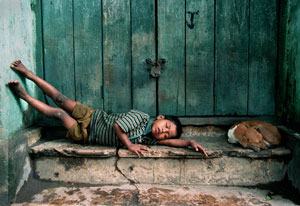US steps up efforts to protect world's children
January / February 2013 | Volume 12, Issue 1

Photo by Sudipto Das/Photoshare
The NIH is participating in a U.S. government plan
to enhance global efforts to protect children.
Aiming to shield the world's children from deprivation, exploitation and danger, the U.S. government recently launched its first-ever Action Plan on Children in Adversity. The initiative underscores that adequate care in early life is essential for producing successful adults and thriving communities, which in turn feed a nation’s social and economic progress.
Specifically, the framework is intended to guide U.S. efforts to improve the lives of children worldwide and states three key goals: to provide strong beginnings, put family care first and protect children from violence, exploitation, abuse and neglect. It also identifies existing programs that work and can be scaled up. The result should be significantly fewer children who fail to meet age-appropriate growth and development milestones, who don’t live in a family structure and who suffer violence or exploitation.
The NIH role in the interagency collaboration includes helping countries collect relevant data so they can develop evidence-based policies and programs. With expanded research, policy makers in target countries can measure the prevalence of various problems, how well corrective steps are working and whether programs are maximizing the use of funds. The NIH will foster collaborations among researchers and monitoring and evaluation teams. It will also ensure that activities conducted by U.S. federally funded researchers are appropriate and culturally relevant.
U.S. agencies participating include: USAID, the Peace Corps and the Departments of Health and Human Services, Agriculture, Defense, Labor and State.
More Information
To view Adobe PDF files,
download current, free accessible plug-ins from Adobe's website.